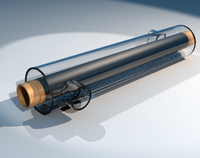
Photo from wikipedia
BACKGROUND Structural properties of the arterial wall are important diagnostic parameters. The current study aimed at investigating the hemodynamic properties and intima-media thickness changes of the common carotid artery in… Click to show full abstract
BACKGROUND Structural properties of the arterial wall are important diagnostic parameters. The current study aimed at investigating the hemodynamic properties and intima-media thickness changes of the common carotid artery in human subjects with atherosclerosis in order to determine the relationships between these indices. METHODS This study presented methods to detect instantaneous changes in the lumen diameter, intima media thickness, longitudinal movement and acceleration, and velocity of the left side of common carotid artery. These parameters were measured in 155 male patients, categorized into control (n = 42), mild (n = 39), moderate (n = 37), and severe (n = 37) carotid stenosis groups by B-mode and Doppler ultrasonography. Extracted parameters were used to estimate the biomechanical properties of arteries, including radial strain, arterial stiffness index, Young's elastic modulus, circumferential stress, shear stress, axial stress, critical bent buckling pressure, and critical buckling torque. FINDINGS All biomechanical parameters of common carotid artery were significantly different in patients with mild, moderate, and severe stenosis, compared to the control group (P < 0.05). Moreover, the current results showed a significant correlation between intima media thickness and non-intima media thickness-based biomechanical indices including circumferential strain, stiffness index, and shear stress in different stenosis groups (P < 0.05). INTERPRETATION We concluded that the conventional and new indicators such as axial stress, critical bent buckling pressure, critical buckling torque could be useful for evaluating atherosclerosis development and also, may provide more information for physicians and interventional radiologists in designing strategies for decreasing risk in interventional treatment such as stent replacement and differentiation of vulnerable plaques.
Journal Title: Clinical biomechanics
Year Published: 2021
Link to full text (if available)
Share on Social Media: Sign Up to like & get
recommendations!